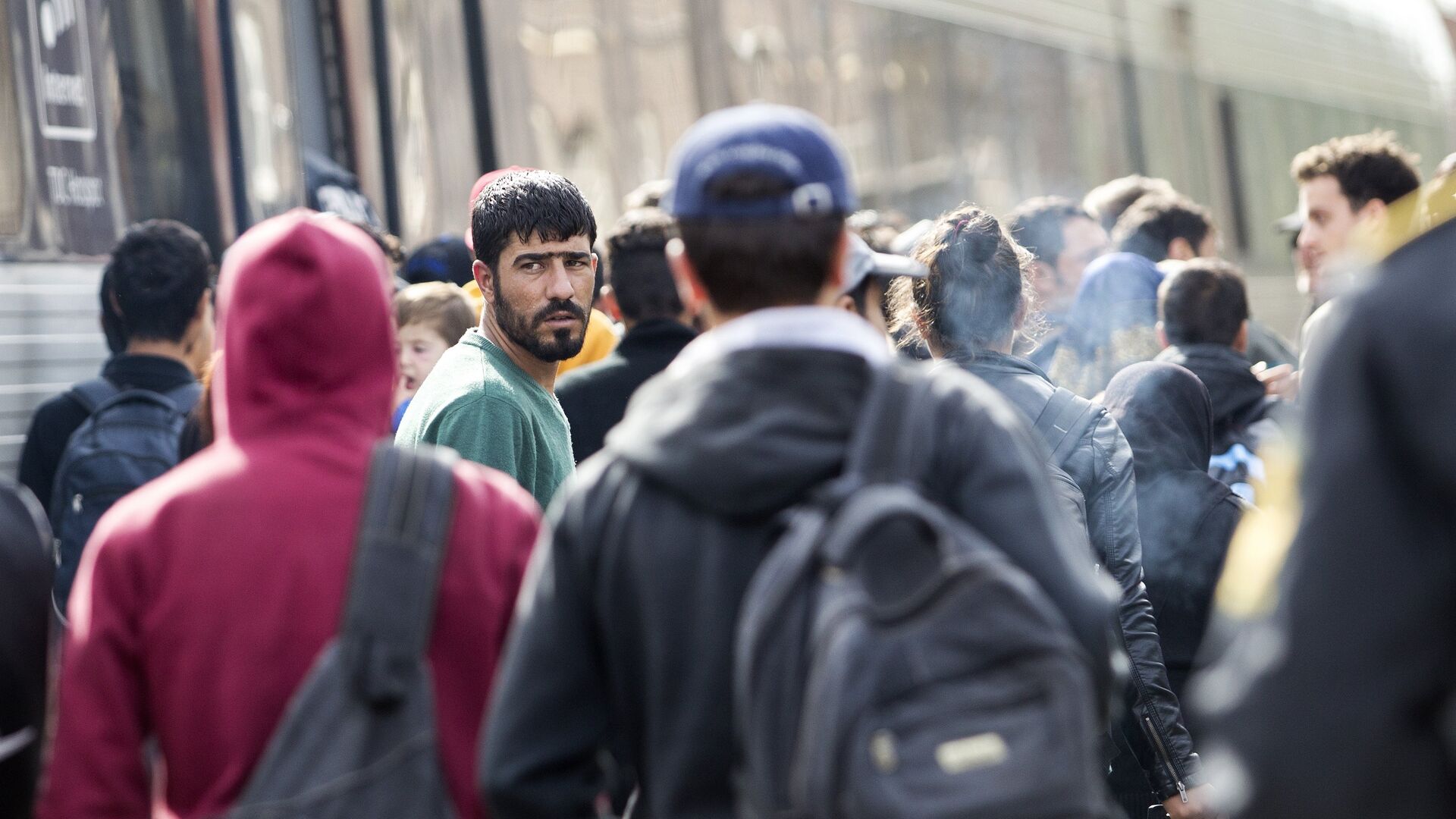https://sputnikglobe.com/20230328/swedes-expected-to-become-minority-in-their-own-countrys-two-largest-cities-1108852857.html
Swedes Expected to Become Minority in Their Own Country's Two Largest Cities
Swedes Expected to Become Minority in Their Own Country's Two Largest Cities
Sputnik International
In Malmo, Sweden's third-largest city, foreign-background residents already are in majority, whereas the corresponding figure nationwide has exceeded a third.
2023-03-28T07:41+0000
2023-03-28T07:41+0000
2023-03-28T08:08+0000
world
scandinavia
sweden
immigration
news
europe
immigrants
illegal immigrants
https://cdn1.img.sputnikglobe.com/img/105365/64/1053656457_0:0:3601:2026_1920x0_80_0_0_1a0077b9304e20c94184c370131b7fef.jpg
The share of the populace with an immigrant background in Sweden continues to rise, recently surpassing a third of the total population of over 10 million.According to the recent figures from Statistics Sweden (SCB), at the start of the year, 34.62% of Sweden's residents had a foreign background going at least one generation back.With the current trends in place, this category will soon become a majority in all of the Nordic nation's three largest cities. In Sweden's third-largest municipality, Malmo, which has long been touted as the Scandinavian country's most multicultural city, boasting diasporas from dozens of countries across the globe, residents there with a foreign background are already in the majority. On December 31, 2022, their numbers surpassed 57.5%.In Gothenburg and Stockholm, the corresponding figures at the turn of the year was nearly 48% and 45.4%, respectively. In some age brackets, foreign-background residents already are a majority. For instance, wholly 65% of Gothenburg residents aged 5 to 9 have an immigrant background.Despite being regularly laughed off by the press and politicians as a "right-wing hoax" and a "racist trope," a drastic population shift is clearly taking place. Sweden has until recently remained a largely homogeneous society, yet several decades of massive immigration starting from the 1980s altered its demographic composition beyond all recognition. Among others, Syrians, Iraqis and Afghans have formed sizable communities in recent years alone, having eclipsed the traditional Finnish minority. While similar trends are being witnessed in neighboring Nordic nations and Western Europe at large, Sweden seems to be miles ahead. The rise in the percentage of people with a non-European background has risen very markedly from having been next to non-existent in the 1960s to an estimated 19% in 2022.This prompted Tobias Hubinette, a researcher of race and multiculturalism at Karlstad University and a self-professed anti-racist activist, to describe Sweden as "the Western world's most diverse and heterogeneous country after the United States."In recent years, immigration and related issues, such as unemployment, crime and a lack of social cohesion, have turned into a defining moment in Swedish politics, with those on the right favoring tougher restrictions, while those on the left advocate a more permissive policy and accuse opponents of everything from "white fragility" and "white privilege" to "xenophobia" and "racism."The current minority government led by the liberal-conservative Moderates has run on a platform of "straightening out Sweden" and claims to be headed towards tightening internal controls and bolstering the fight against illegal immigration. The government also stressed its lasting emphasis on what it dubbed a "voluntary repatriation." All of this was almost unthinkable barely a decade ago, as the very same Moderates during their previous stint in power aspired to turn Sweden into a "humanitarian superpower." Nevertheless, even with limitations in place, the demographic trends largely favor the immigrants and their descendants.
https://sputnikglobe.com/20210420/swedes-will-become-minority-in-their-own-country-in-less-than-half-a-century-researcher-says-1082675994.html
scandinavia
sweden
Sputnik International
feedback@sputniknews.com
+74956456601
MIA „Rossiya Segodnya“
2023
News
en_EN
Sputnik International
feedback@sputniknews.com
+74956456601
MIA „Rossiya Segodnya“
Sputnik International
feedback@sputniknews.com
+74956456601
MIA „Rossiya Segodnya“
mass immigration, foreign background, demographic trends, foreign diasporas, watershed issue, sweden as humanitarian superpower
mass immigration, foreign background, demographic trends, foreign diasporas, watershed issue, sweden as humanitarian superpower
Swedes Expected to Become Minority in Their Own Country's Two Largest Cities
07:41 GMT 28.03.2023 (Updated: 08:08 GMT 28.03.2023) In Malmo, Sweden's third-largest city, citizens with an immigrant background are already in the majority, while the corresponding figure nationwide has exceeded a third.
The share of the populace with an immigrant background in Sweden continues to rise, recently surpassing a third of the total population of over 10 million.
According to the recent figures from Statistics Sweden (SCB), at the start of the year, 34.62% of Sweden's residents had a foreign background going at least one generation back.
With the current trends in place, this category will soon become a majority in all of the Nordic nation's three largest cities. In Sweden's third-largest municipality, Malmo, which has long been touted as the Scandinavian country's most multicultural city, boasting diasporas from dozens of countries across the globe, residents there with a foreign background are already in the majority. On December 31, 2022, their numbers surpassed 57.5%.
In Gothenburg and Stockholm, the corresponding figures at the turn of the year was nearly 48% and 45.4%, respectively. In some age brackets, foreign-background residents already are a majority. For instance, wholly 65% of Gothenburg residents aged 5 to 9 have an immigrant background.
Despite being regularly laughed off by the press and politicians as a "right-wing hoax" and a "racist trope," a drastic population shift is clearly taking place. Sweden has until recently remained a largely homogeneous society, yet several decades of massive immigration starting from the 1980s altered its demographic composition beyond all recognition. Among others, Syrians, Iraqis and Afghans have formed sizable communities in recent years alone, having eclipsed the traditional Finnish minority. While similar trends are being witnessed in neighboring Nordic nations and Western Europe at large, Sweden seems to be miles ahead. The rise in the percentage of people with a non-European background has risen very markedly from having been next to non-existent in the 1960s to an estimated 19% in 2022.
This prompted Tobias Hubinette, a researcher of race and multiculturalism at Karlstad University and a self-professed anti-racist activist, to describe Sweden as "the Western world's most diverse and heterogeneous country after the United States."
"The US takes the gold here, whereas as Sweden shares the silver with a handful of other countries, such as Canada, Australia, New Zealand, France, the UK and the Netherlands," Hubinette blogged.
In recent years, immigration and related issues, such as
unemployment,
crime and a lack of social cohesion, have turned into a defining moment in Swedish politics, with those on the right favoring tougher restrictions, while those on the left advocate a more permissive policy and accuse opponents of everything from "white fragility" and "white privilege" to "xenophobia" and "racism."
The current minority government led by the liberal-conservative Moderates has run on a platform of "straightening out Sweden" and claims to be headed towards tightening internal controls and bolstering the fight against illegal immigration. The government also stressed its lasting emphasis on what it dubbed a "
voluntary repatriation." All of this was almost unthinkable barely a decade ago, as the very same Moderates during their previous stint in power aspired to turn Sweden into a "humanitarian superpower." Nevertheless, even with limitations in place, the demographic trends largely favor the immigrants and their descendants
.


